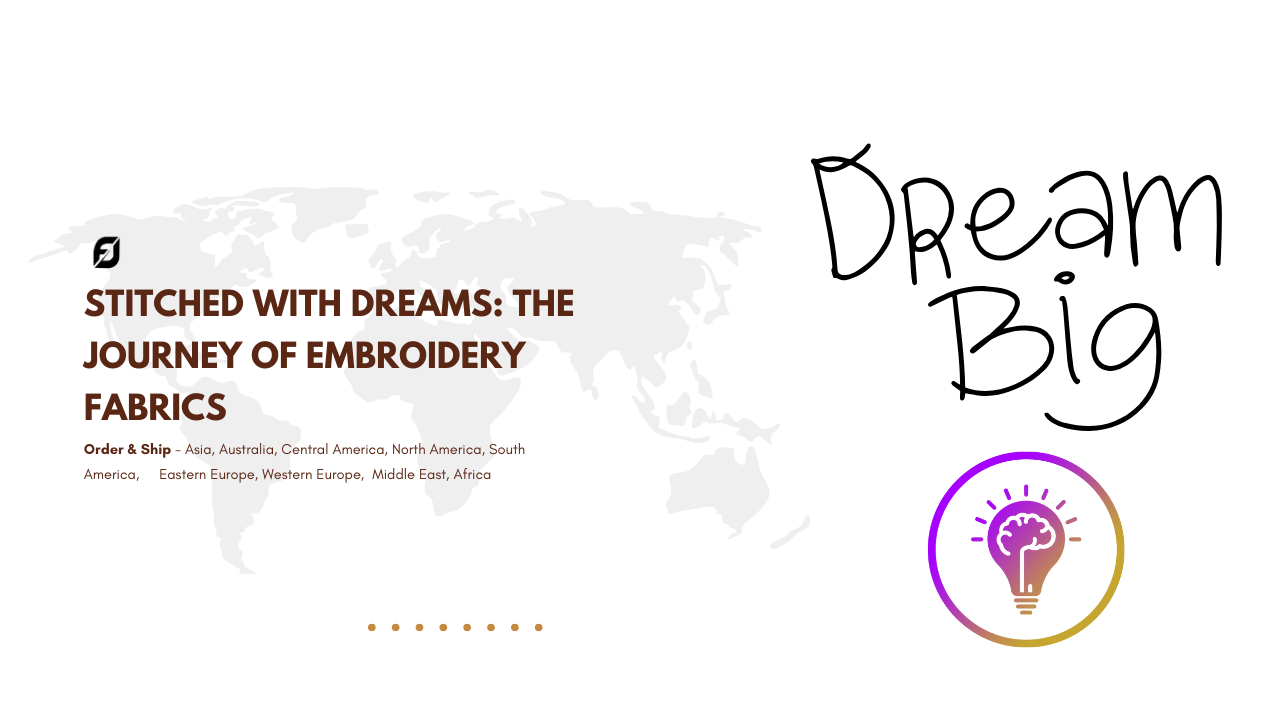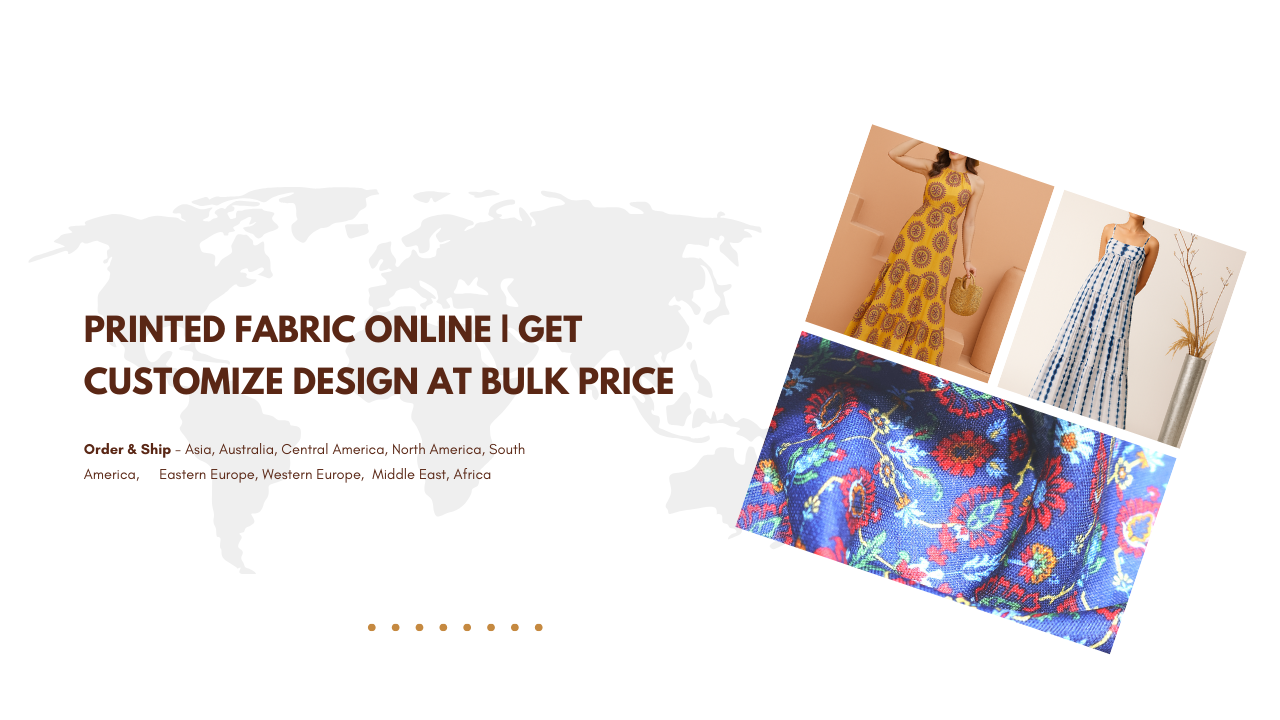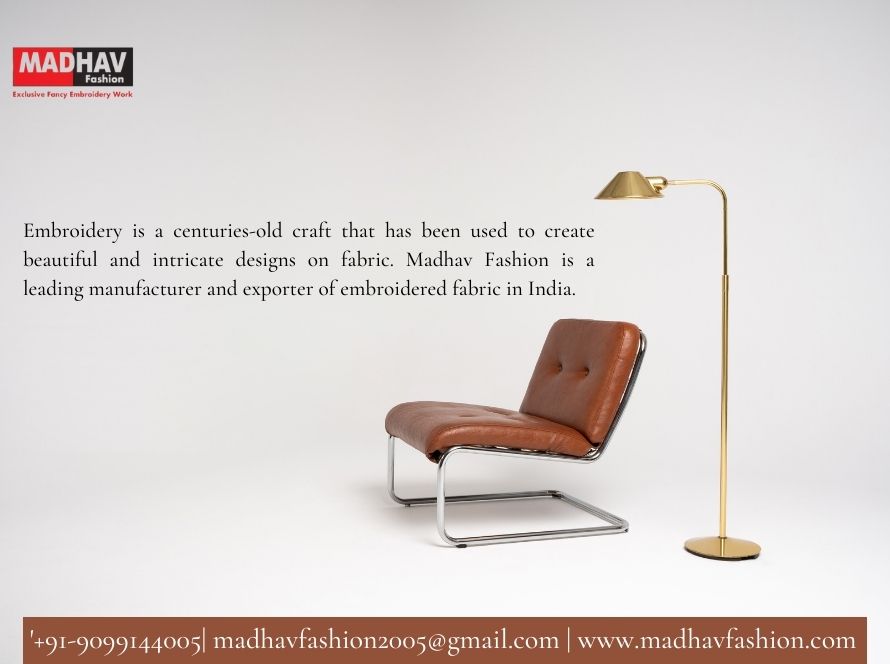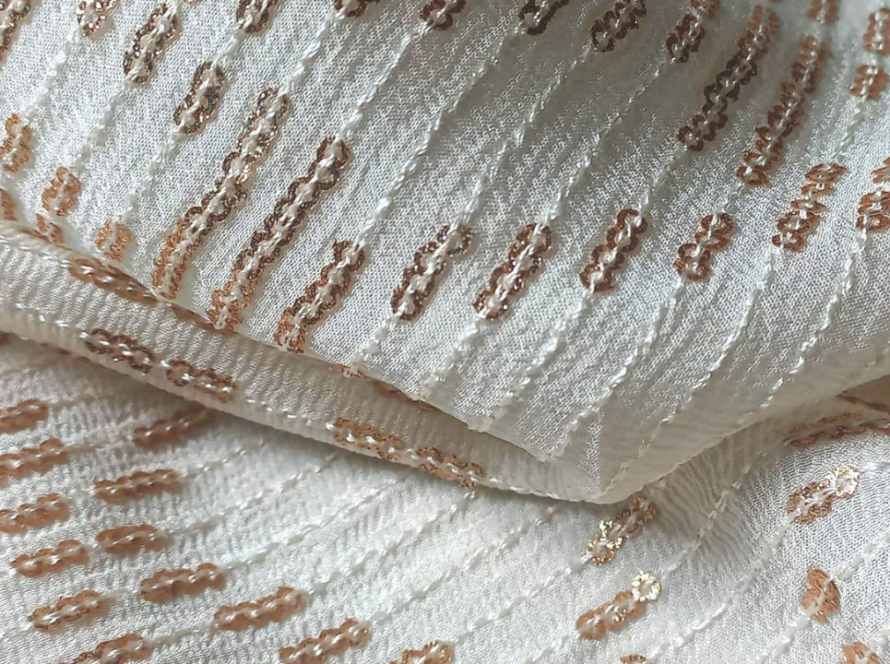Tissue embroidery fabric is a luxurious, shimmering fabric, known for its light weight and elegant finish.
It has gained immense popularity for making exquisite garments such as sarees, lehengas, anarkalis, and more.
Tissue Embroidery Fabric: A Complete Guide to Tissue Fabric and Its Use in Apparel
we’ll explore what tissue fabric is, its types, the kind of apparel made from it, and how Madhav Fashion is revolutionizing the tissue embroidery fabric market not only in India but globally.
What is Tissue Fabric?
Tissue fabric is a type of material made from a blend of silk or synthetic fibers woven together with metallic threads. This gives it a shiny, lustrous surface that’s both light and delicate. Tissue fabric is often associated with high-end fashion due to its regal appearance, making it a preferred choice for special occasions like weddings and festivals.
Types of Tissue Fabric
There are several types of tissue fabric, each offering unique textures and aesthetics. The most popular types include:
- Silk Tissue Fabric: Made from pure silk, this is the finest form of tissue fabric, renowned for its luxurious feel and natural sheen.
- Cotton Tissue Fabric: A blend of cotton with metallic yarns, giving it a balance of comfort and shine.
- Zari Tissue Fabric: This type of tissue fabric is heavily woven with zari (metallic threads), offering a rich, traditional appearance.
- Synthetic Tissue Fabric: Made from polyester or other synthetic fibers, this is a more affordable version with similar shimmering properties.
Apparel Made from Tissue Fabric
Tissue fabric is highly versatile and used in various types of apparel, especially for women’s ethnic wear. Some of the most popular garments made from tissue fabric include:
- Sarees: Tissue sarees are a timeless fashion statement, known for their lightweight drape and shimmery effect.
- Lehengas: Tissue fabric is ideal for bridal and festive lehengas, providing a glamorous appearance with intricate embroidery.
- Anarkalis: The flowing structure of anarkalis looks even more elegant when made from tissue fabric.
- Kurtis and Tunics: Lighter tissue fabrics are used to make kurtis and tunics for festive and formal occasions.
- Dupattas: Tissue dupattas are often used to add an extra layer of elegance to traditional outfits.
Can Heavy Embroidery Be Done on Tissue Fabric?
Yes, tissue fabric can handle various types of embroidery, including heavy work. Embellishments such as zari, sequins, and beads are commonly used to enhance its beauty. Tissue embroidery fabric is perfect for making grand, opulent outfits like bridal lehengas, sarees, and anarkalis. Madhav Fashion, a leader in fabric manufacturing, specializes in producing tissue fabrics with intricate embroidery work, which makes them ideal for designers and boutiques.
Dyeing, Colors, and Digital Printing on Tissue Fabric
Tissue fabric is dyeable, meaning it can be transformed into a variety of colors, making it a flexible choice for designers who want to experiment with different shades. However, there are a few distinctions between plain dyed fabric, colored fabric, and digitally printed fabric:
- Plain Dyed Tissue Fabric: This is fabric that has been dyed in solid colors, retaining the metallic shimmer of the tissue material.
- Colored Tissue Fabric: Often, colored tissue fabric includes metallic threads that give the color a reflective quality.
- Digital Printed Tissue Fabric: While digital printing can be done on tissue fabric, the delicate nature of the material means that subtle, detailed prints work best. Digital printing on tissue is commonly used for modern, contemporary designs.
Popularity of Tissue Embroidery Fabric
Tissue embroidery fabric is highly popular in India and abroad, especially in countries with a rich tradition of ethnic wear. In India, cities like Delhi, Mumbai, Kolkata, and Jaipur are hotspots for tissue fabric demand. Internationally, tissue embroidery fabric is gaining attention in countries like the United States, the United Kingdom, UAE, and Canada, where the Indian diaspora continues to cherish traditional ethnic clothing.
Madhav Fashion’s Tissue Embroidery Fabric
Madhav Fashion is a leading manufacturer of tissue embroidery fabric, known for its intricate designs and premium quality. The company caters to both domestic and international markets, offering customized tissue fabrics to meet the demands of top designers, boutiques, and garment manufacturers. Their tissue fabrics are highly popular for crafting lehengas, kali work, sarees, and more. Madhav Fashion’s tissue embroidery fabric stands out for its versatility and appeal, making it a top choice for fashion designers around the world.
Types of Garments Made from Tissue Embroidery Fabric
Tissue embroidery fabric is a favorite for making stunning traditional garments such as:
- Kali Lehengas: Known for their flared appearance, kali lehengas crafted from tissue fabric offer a majestic look.
- Sarees: Tissue sarees with heavy embroidery are perfect for weddings and other special occasions.
- Anarkalis: The flowing, voluminous structure of anarkalis looks regal when made from tissue fabric with intricate embroidery.
- Dupattas and Shawls: These accessories add a touch of sophistication when made from tissue fabric.
Tissue embroidery fabric is one of the most luxurious and versatile materials in the world of ethnic fashion. With its shimmering appearance and ability to hold heavy embroidery, tissue fabric is a go-to choice for creating high-end, glamorous outfits.
Madhav Fashion is at the forefront of tissue fabric production, providing high-quality materials to designers and manufacturers globally. Whether it’s a grand kali lehenga or a flowing tissue saree, this fabric adds an unmatched elegance to any outfit.
___________________________________
What is tissue embroidery fabric, and how is it made?
Tissue embroidery fabric is a luxurious, lightweight material made by weaving metallic threads, silk, or synthetic fibers together. It’s popular in ethnic and high-end fashion due to its shiny and shimmering appearance. The fabric offers a rich, elegant look, making it ideal for special occasion wear, such as wedding sarees, lehengas, and anarkalis.
The metallic yarns in tissue fabric create its characteristic sheen, while silk or synthetic fibers lend it a soft texture. These elements combine to make tissue fabric not only beautiful but also delicate. The embroidery on tissue fabric involves various techniques, including zari, sequins, and beadwork. Due to its lightweight nature, tissue fabric can handle both subtle and heavy embroidery designs.
Tissue embroidery fabric is ideal for creating apparel that looks grand without being too heavy. The fabric’s structure allows intricate embroidery patterns to stand out, making it a popular choice for bridal wear, festive outfits, and high-fashion designs. With advancements in textile technology, tissue fabric can be dyed in vibrant colors and can even feature modern digital prints.
What are the different types of tissue fabric available in the market?
There are several types of tissue fabric, each offering unique features and applications in fashion:
- Silk Tissue Fabric: This is made from pure silk and is the most luxurious type. Known for its natural sheen and softness, it is often used in high-end sarees, lehengas, and dupattas.
- Cotton Tissue Fabric: A blend of cotton and metallic yarns, this fabric provides a balance between comfort and elegance. Cotton tissue fabric is perfect for ethnic wear like kurtas and tunics.
- Zari Tissue Fabric: Heavily woven with metallic threads like gold or silver zari, this type has a traditional appeal. It’s commonly used for wedding sarees, lehengas, and dupattas.
- Synthetic Tissue Fabric: Made from synthetic fibers like polyester, this type of tissue fabric mimics the shine of silk but is more affordable. It’s often used for casual ethnic wear and light dupattas.
Each type of tissue fabric has unique properties and can be used for different purposes, from casual ethnic outfits to elaborate bridal ensembles.
Can heavy embroidery be done on tissue fabric?
Yes, heavy embroidery can be done on tissue fabric. The fabric’s smooth surface and shimmering appearance make it an excellent base for intricate and heavy embroidery work. Techniques like zari, sequins, beadwork, and even mirror work are often applied to enhance the elegance of tissue fabric.
Designers frequently use tissue fabric for bridal lehengas, sarees, and anarkalis, where heavy embroidery adds grandeur and opulence. The fabric’s ability to hold its structure, despite being lightweight, makes it suitable for detailed and intricate embroidery patterns. However, care must be taken to ensure that the embroidery work does not weigh down the fabric excessively, as tissue is delicate.
Brands like Madhav Fashion specialize in producing tissue embroidery fabrics, offering customized options for designers and manufacturers. Heavy embroidery on tissue fabric can transform a simple garment into a stunning masterpiece, perfect for weddings, festivals, and other grand events.
What kind of garments can be made from tissue embroidery fabric?
Tissue embroidery fabric is a versatile material used to make a wide range of ethnic and festive wear. Some of the most popular garments include:
- Sarees: Tissue sarees are known for their lightweight feel and luxurious shimmer, often used for bridal wear or festive occasions.
- Lehengas: Bridal and festive lehengas made from tissue fabric exude glamour and grandeur. Heavy embroidery on tissue fabric makes these lehengas a popular choice for weddings.
- Anarkalis: Flowing anarkalis crafted from tissue fabric offer a regal look, especially when paired with intricate embroidery work.
- Dupattas: Tissue dupattas add a touch of elegance to any ethnic outfit, especially when embroidered with sequins or zari.
Other garments like kurtis, tunics, and shawls can also be made from tissue embroidery fabric, adding sophistication and charm to everyday ethnic wear.
Is tissue fabric dyeable, and how does it differ from colored or digitally printed tissue fabric?
Yes, tissue fabric is dyeable, which allows designers to experiment with various shades and create unique fashion pieces. The dyeing process enhances the fabric’s natural sheen, and metallic threads woven into the fabric catch the light differently, giving the color an iridescent effect.
Here’s how dyeable, colored, and digitally printed tissue fabrics differ:
- Dyeable Tissue Fabric: This type is treated to absorb dyes evenly, giving the fabric a uniform color while preserving its natural shine.
- Colored Tissue Fabric: Colored tissue fabric typically has metallic threads in gold or silver that reflect the color and give the fabric a multi-dimensional appearance.
- Digital Print Tissue Fabric: Digital printing involves printing intricate designs directly onto the fabric. Tissue fabric can hold delicate digital prints well, making it suitable for modern designs and contemporary ethnic wear.
The flexibility of tissue fabric in dyeing and printing makes it a popular choice among designers for creating both traditional and contemporary outfits.
Which countries and regions prefer tissue embroidery fabric the most?
Tissue embroidery fabric is highly popular in India, particularly for ethnic wear like sarees, lehengas, and anarkalis. In cities like Delhi, Mumbai, Kolkata, and Jaipur, tissue fabric is a top choice for bridal and festive outfits due to its luxurious look and ability to carry heavy embroidery.
Internationally, tissue embroidery fabric has gained popularity in countries with a large Indian diaspora, including:
- United States: The Indian-American community embraces tissue fabric for weddings and festive events.
- United Kingdom: Tissue fabric is a popular choice for high-end Indian bridal outfits.
- United Arab Emirates (UAE): The luxurious lifestyle in cities like Dubai makes tissue fabric a favorite for Indian ethnic wear.
- Canada: Ethnic boutiques across Canada offer tissue sarees, lehengas, and anarkalis to the South Asian community.
Madhav Fashion is one of the leading exporters of tissue embroidery fabric, catering to international designers and boutiques in these regions.
What are the most common types of embroidery used on tissue fabric?
Tissue fabric can hold a variety of embroidery styles, ranging from light to heavy work. Some of the most common types of embroidery on tissue fabric include:
- Zari Work: One of the most popular techniques, zari work uses gold or silver threads to create intricate patterns on tissue fabric. This is commonly used for bridal sarees and lehengas.
- Sequins Work: Sequins add sparkle to tissue fabric, making it an excellent choice for festive garments and party wear.
- Mirror Work: Although lightweight, tissue fabric can carry mirror work well, giving outfits a traditional and ethnic look.
- Beadwork and Embellishments: Tissue fabric is ideal for beadwork, making it a top choice for luxurious garments like bridal lehengas and anarkalis.
These embroidery styles add depth and texture to the already lustrous surface of tissue fabric, enhancing its overall appeal.
What are the benefits of using tissue fabric for making ethnic wear?
Tissue fabric offers numerous benefits for ethnic wear, making it a popular choice among designers and consumers alike:
- Lightweight and Comfortable: Despite its luxurious look, tissue fabric is extremely light and comfortable to wear. This makes it perfect for creating sarees, lehengas, and dupattas that look heavy but feel light on the body.
- Shimmering Appearance: The metallic threads woven into tissue fabric give it a naturally shimmering look, adding a touch of glamour to ethnic wear.
- Versatile for Embroidery: Tissue fabric can hold various types of embroidery, from light zari work to heavy sequins and beadwork.
- Perfect for Special Occasions: Tissue fabric is often used in bridal and festive wear due to its luxurious appearance. It’s also great for party wear and traditional events like weddings and festivals.
Overall, tissue fabric combines elegance, comfort, and versatility, making it a top choice for ethnic wear.
How does tissue embroidery fabric compare to other fabrics like silk or georgette?
Tissue embroidery fabric is unique in its shimmering appearance, created by weaving metallic threads with silk or synthetic fibers. Here’s how it compares to other fabrics:
- Tissue vs. Silk: While silk is known for its smooth texture and natural sheen, tissue fabric offers a more reflective, metallic shine. Tissue fabric is also lighter than silk, making it a better option for those looking for comfortable ethnic wear that doesn’t compromise on glamour.
- Tissue vs. Georgette: Georgette is a lightweight, flowing fabric, commonly used for sarees and lehengas. While georgette offers a matte look, tissue fabric provides a glossy, reflective finish. Tissue fabric can also carry heavier embroidery, whereas georgette is usually used for lighter work.
Overall, tissue fabric offers a unique combination of lightweight comfort and rich, luxurious shine that sets it apart from other fabrics.
Why is Madhav Fashion considered a leader in tissue embroidery fabric?
Madhav Fashion is recognized as one of the top manufacturers and suppliers of tissue embroidery fabric in India and internationally. Here’s why they stand out:
- Customization: Madhav Fashion offers extensive customization options, allowing designers and manufacturers to create tissue fabric in specific colors, designs, and embroidery styles to suit their needs.
- Premium Quality: The company uses high-quality metallic threads, silk, and synthetic fibers to create tissue fabrics that are both durable and luxurious.
- Wide Range of Offerings: Madhav Fashion produces a variety of tissue fabrics, including silk tissue, zari tissue, and synthetic tissue, catering to different market segments.
- Global Reach: With exports to several countries, Madhav Fashion has established itself as a reliable supplier of premium tissue embroidery fabric for ethnic wear, bridal collections, and high-fashion garments.






